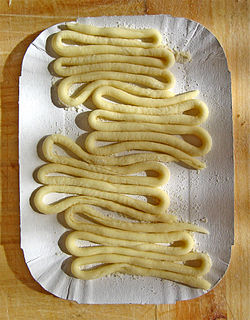 Pici made with egg white | |
| Alternative names | Pinci |
|---|---|
| Type | Pasta |
| Place of origin | Italy |
| Region or state | Province of Arezzo, province of Firenze, province of Grosseto, and province of Siena, Tuscany |
| Main ingredients | Wheat flour, water |
Pici (Italian: [ˈpiːtʃi]; locally [ˈpiːʃi]) is thick, hand-rolled pasta, like fat spaghetti.[1] It originates in the province of Siena, in Tuscany; in the Montalcino area they are also referred to as pinci (Italian: [ˈpintʃi]).
The dough is typically made from flour and water only. The addition of egg is optional, being determined by family traditions. Alternatively, finely chopped or shredded spinach can be used in place of water.
The dough is rolled out in a thick flat sheet, then cut into strips. In some families, the strip of dough is rolled between one palm and the table, while the other hand is wrapped with the rest of the strip. It can also be formed by rolling the strip between the palms. Either method forms a thick pasta, slightly thinner than a common pencil. Due to its handmade nature, this pasta is not uniform in size and has variations of thickness along its length.
It is eaten with a variety of sauces and meats, particularly:
| Food category | Italian | English |
|---|---|---|
| sauces | briciole | breadcrumbs |
| aglione | spicy garlic tomato sauce | |
| boscaiola | porcini mushrooms | |
| cacio e pepe | cheese and black pepper | |
| ragù | a meat-based sauce | |
| game meat | cinghiale | wild boar |
| lepre | hare | |
| anatra | duck |